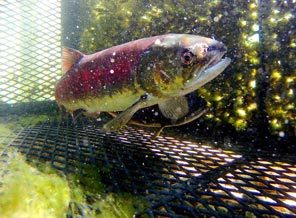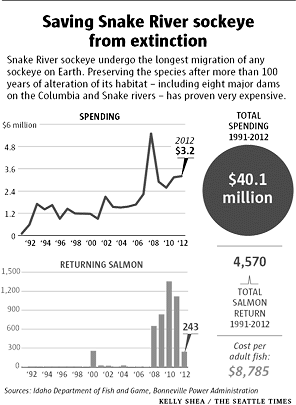forum
library
tutorial
contact

The Extraordinary Effort to Save Sockeye Salmon
by Lynda V. MapesSeattle Times, November 17, 2012
|
the film forum library tutorial contact |

|
The Extraordinary Effort to Save Sockeye Salmonby Lynda V. MapesSeattle Times, November 17, 2012 |
After 20 years and more than $40 million spent, the new direction for Snake River sockeye
"Even my own mother thinks it's crazy," Heindel said. "If I can't sell it to her, I'm not sure I can sell it to the average Joe."
focuses on rebuilding population rather than just preventing extinction. But will it work?
 REDFISH LAKE CREEK, Idaho -- A vermilion slash in clear, cold water, the Snake River sockeye in this mountain stream is one of nature's long-distance athletes, traveling at least 900 miles to get here.
REDFISH LAKE CREEK, Idaho -- A vermilion slash in clear, cold water, the Snake River sockeye in this mountain stream is one of nature's long-distance athletes, traveling at least 900 miles to get here.
That this fish can make such a journey -- the longest of any sockeye in the world -- is remarkable. But it's more incredible that this fish is still around at all.
Down to just one known fish -- dubbed Lonesome Larry -- in 1992, state, tribal and federal fish managers have painstakingly preserved the species in captivity ever since.
Twenty years and $40 million later, they have a new goal. Not just mere survival for Snake River sockeye, but rebuilding the run to at least 2,500 wild fish, free of any hatchery influence, making the epic journey all the way from the Pacific across a time zone to the high mountain lakes of Idaho.
To appreciate how big a step that is, consider this: It's taken fish managers in six federal, state and tribal agencies to get this far. They oversee the lives of these fish, plotting their genetics on spreadsheets, mixing their gametes in plastic bags, and whisking them in various life stages around the Pacific Northwest in plastic shipping tubes, barges, trucks and planes, using five different facilities in three states to hatch, incubate and rear them, in both fresh water and salt.
By now, Bonneville Power Administration ratepayers have spent nearly $9,000 for every sockeye that's made it back to Idaho since this all started in 1991.
The sockeye rescue is part of a much larger Columbia River Basin Fish and Wildlife program -- believed to be the largest of its kind in the world -- that has cost Bonneville ratepayers more than $12 billion since 1978, depending on how you count it.
While Elwha Dam removal cost U.S. taxpayers $325 million, BPA ratepayers spend more than $200 million each year -- including $311 million budgeted this year alone -- on programs intended to restore fish, wildlife and habitat harmed by the Columbia and Lower Snake River dams. It adds up: The program's cost accounts for one-third of the wholesale rate Bonneville charges utilities that use its power, including Seattle City Light, which buys 41 percent of its power from BPA.
A recent jump in sockeye returns, including more than 1,000 fish in both 2010 and 2011, encouraged managers to expand the program and break ground on a new, $14 million hatchery this year. The goal now is way beyond just saving sockeye from extinction, and on to building a wild, self-sustaining population.
It's quite a comeback. The captive brood program was nearly canceled in 2006, because so few sockeye were making it back to Idaho. "We thought it was a little bit of a moonshot," said Rick Williams, a member of a scientific panel that recommended against continuing to fund the program.
The Northwest Power and Conservation Council, appointed by governors from four Western states, voted to keep it going anyway, after Idaho's governor asked members to vote with their hearts, not their heads. Then came a couple of good years of sockeye returns. Last summer, the council doubled down, voting to expand the program and build the hatchery.
Lorri Bodi, BPA's vice president for environment, fish and wildlife, said she was glad nobody pulled the plug on Snake River sockeye. She has a photo in her office of herself releasing one of the fish back to Redfish Lake to spawn a few years ago, a feel-good moment that still gives her hope. "We went from zero to four fish coming back every year. They were functionally extinct. Now, in good years, we have more than 1,000. We are going to take it to the next level. ... This is a testament to optimism.
"Our goal is to have a few thousand sockeye again, just as we did in the 1950s, before human impacts were so severe. It's a pretty cool thing to do."
The issue of dams
But where some see cause for optimism, others see denial. Idaho, Oregon and Washington are replete with hatcheries, but 16 runs of salmon and steelhead in the Columbia Basin are still listed for protection under the Endangered Species Act. And despite a few good years of returns, Snake River sockeye remain endangered. Just 243 sockeye made it back to Idaho this year.
With eight dams between their spawning grounds and the Pacific, hatchery production alone won't be enough to rebuild healthy, naturally spawning populations of Snake River sockeye and other Columbia Basin salmon and steelhead, said Joseph Bogaard, outreach director in the Seattle office of the Save Our Wild Salmon Coalition, a nonprofit that advocates for dam removal on the Lower Snake River.
"There was a lot of opposition to this emergency-room life support and a sense that it would not work, and that if it did, it would become a replacement for dealing with the deeper, more difficult issues," Bogaard said. "We were thankfully wrong on the first issue; it has provided a new opportunity for sockeye. But it has also been so politically easier to find the money to do this than deal with the real issues.
"It's more of the same, kicking the can down the road, and it's certainly not working for us," Bogaard said of the new sockeye hatchery.
Jim Lichatowich, author of "Salmon Without Rivers," sees agencies protecting their comfort zone, instead of salmon. "Building a large hatchery infrastructure to try to compensate for the dams is the status quo; it is the comfort zone for the management agencies," Lichatowich said. "Agencies get big budgets to run them, and politicians get credit for solving the problem. But the fact is ... hatcheries haven't been measuring up, otherwise we wouldn't have so many salmon in the Columbia Snake Basin that are listed."
Jeff Heindel, deputy director of hatchery programs for Idaho, says he knows he faces skepticism, as Northwest ratepayers pour even more money into Snake River sockeye.
"Even my own mother thinks it's crazy," Heindel said. "If I can't sell it to her, I'm not sure I can sell it to the average Joe."
 Larry's descendants
Larry's descendants
The extraordinary effort that has gone into preserving Snake River sockeye is not unusual. There are dozens of publicly funded efforts, most of them run by the U.S. Fish and Wildlife Service, under way around the country to bank the genes of devastated populations of animals, from red wolves to black-footed ferrets. By definition, the programs require extreme measures to sustain small populations of animals in totally artificial settings.
In a building outside Boise, sockeye kept in the captive brood program circle in fiberglass pools. Fed on the hour, they are grown to adult size, graduating to ever-larger tubs. Exercise is provided by a jet of water sputtering in the tubs, against which the fish steadily swim.
They live somewhere between captive rearing and extinction; no longer wild animals, but not gone from the Earth, either.
"Slimy little suckers," says a technician as a fish he lifts to check for weight and length slides from his hands and hits the deck. Quickly picking it up and blotting its abundant slime with a paper towel, he measures the fish and puts it back, unharmed, in its tank. Fish techs dubbed the food that fattens these fish "beefcake." But while they will bulk up, captive-reared sockeye are slimier, dimmer in color and less fecund than the wild fish from which they descend.
Go back to the beginning, and you'll meet Lonesome Larry, so-called because he was the only sockeye to return to Redfish Lake in 1992. With no mate with which to spawn, Larry was injected with hormones to pump up his milt production; stripped of his gametes, killed, stuffed and mounted in a nearby nature center. His milt was stored in liquid nitrogen, to dribble out year by year.
Descended from Lonesome Larry and other founders of the captive brood, some of these fish in the baby pools every year are allowed conjugal visits to Redfish Lake to reproduce on their own, along with some fish returned to the lake after capture.
Amazingly, Heindel says, the fish reared in captivity still understand their primal task, and head to the southeast end of Redfish Lake, as their wild forebears did, to successfully spawn.
Today, every sockeye returning to the Stanley Basin of Idaho is trapped by the state's department of fish and game at its Sawtooth Hatchery and at Redfish Lake Creek. From there, they are driven two and a half hours to a hatchery complex outside Boise, where the captive brood program is located.
Driving six sockeye to Eagle one day last August, Dan Baker, manager of the Eagle hatchery, kept an eye on a dashboard light glowing green to assure him oxygen was still bubbling in the chilled water in the box in the back of the pickup.
He stopped at a gas station mid-journey, and popped the top to check on the fish, as a fluffy dog came tail-wagging over. One fish tipped its nose out of the water, making for the edge, but Baker was too quick for it, and thunked down the lid. "Haven't lost one yet," he said, climbing back into the truck.
A battery of technicians was waiting when he arrived, to work up the new fish. In less time than it takes to make a sandwich, they cataloged each fish, then scanned it for tags, measured it, weighed it, yanked off a scale with forceps to confirm the sockeye's age, clipped off a hunk of fin for DNA analysis, crunched a hole in its dorsal fin with a hole punch to snug on a zip-tie tag, and injected the fish with a hypodermic full of antibiotics plunged in its side.
A technician dropped the last, limp fish in a holding tank full of water dosed with disinfectant. From here, some of the fish would be trucked back to Stanley, and returned to spawn in Redfish Lake.
But for the rest, this was the end of the road: new genes for the captive brood.
Related Pages:
Bluefish.org offers $1000 Reward to anyone who can reveal how the federal plan will recover Idaho's Sockeye Salmon.
learn more on topics covered in the film
see the video
read the script
learn the songs
discussion forum
